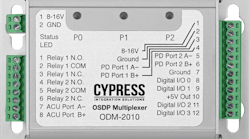Nobody disputes the need for building security. Whether an office complex, a school, a retail shop, a power plant or any number of other facilities, access control systems have become an integral part of daily life. But now we are starting to see a decided shift away from cable-intensive, analog-based card key systems to more cost-efficient, more easily managed, network-based physical access control systems (PACS). In fact, Joseph Gittens, Director of the SIA Standards Committee, was recently quoted as saying, “IP-based communications have become the recognized communications framework within access control as well as the physical security industry as a whole.”
So how can integrators capitalize on this growing trend? The key is to understand the underlying advantages of this new technology and create a system that lets customers reap the full benefits. The goal is the same as with any access control proposal: Keep people and assets safe by restricting WHO can enter, WHERE they can go and WHEN they can go through the facility doors. But the open architecture of an IP-based platform means that a network-based PACS can do so much more. (See The Case for IP Access Control, SD&I February 2014 and Why PACS Are Moving to the Edge, SD&I June 2014.)
Start with a Needs Assessment
In an access control scenario, the needs assessment begins with a building walk around to determine the risks associated with protecting the most valuable resources: people and property. Then one needs to ask: How can PACS help to create a safe environment for employees, students, visitors, tradespeople, shoppers, etc.? Parsing that further: How can a network-based PACS protect them during the work day, as they leave at the end of shift and when they remain in the building after hours?
When I first started selling security solutions a number of decades ago, my manager taught me to closely scrutinize the facility for vulnerabilities from the moment I stepped out of my car for the appointment. Walk the perimeter. Check the parking lot for sufficient lighting. Look where surveillance cameras are placed. On entering the lobby of the facility, see if there is any door security beyond a human receptionist. If the doors have keypads, card readers and cameras, what condition are they in?
I have always found this preliminary intelligence gathering gave me the foundation I needed to ask the customer leading questions about their approach to security. In turn, their answers gave me a good understanding of the risks they faced and what they currently had in place to address them. It may sound like Basic Salesmanship 101, but sometimes in our eagerness to sell a certain product we forget that with a well-placed question we can help the customer get to the crux of their problem more quickly.
Involve IT in the discussion
Given that PACS often piggybacks on existing infrastructure under IT’s domain, it only makes sense to include them in the discussion. Even if they are not the ultimate decision-makers, they can certainly influence the sale. But with so many of today’s systems migrating to IP — video, access control, environmental control, fire alarms, etc. — you might find that your prospect’s security and facility management groups fall under the IT department in the corporate hierarchy — so IT better be sitting at the table.
The first topic of discussion should be whether PACS will reside on the existing network or will operate under its own separate network. The answer to that question will certainly impact the design of your proposal and the economies and efficiencies the customer can expect to realize. The next series of questions can help you clarify the parameters of the project:
- Is the customer aware of all the PACS technology choices currently on the market or are they looking to the integrator for recommendations?
- Is there a third-party consultant involved in the project? If so, what skills are they bringing to the table?
- Is there a design already in place that the integrator is expected to follow? Will the integrator have to provide as-built drawings?
The next group of questions should address what happens once the system is up and running:
- Will the system be managed internally by the customer?
- Will the PACS be provided as a managed system whereby the integrator provides all changes, additions, reporting, etc. for a service fee?
- Will there be remote locations included under the system?
- If there are remote locations, will they be managed at those sites or from the main location?
- Do they want a hosted access control solution where they can make their own changes remotely (such as adding and deleting credentials) using the web?
- Will an employee’s credentials need to function at all locations or only a select few?
- Do operators need to monitor events live or will reports be reviewed offline?
And then there are the questions regarding integration with other security systems.
- Do they need to integrate the PACS with their video surveillance system? If so, to what extent?
- Is there an existing physical security information management system (PSIM) in place today?
- Will the PACS need to be integrated with this system as well?
- Are there high security areas where biometric credentials will be mandatory to verify the true identity of a person?
These are just a few examples of the many questions you might ask. It all depends on the type of facility being surveyed, the vulnerabilities it presents and the level of security the customer hopes to achieve.
The key is to be as thorough as possible. Uncover as many answers as you can so that the proposal you design accurately reflects the risks and needs of the customer. The other half of the process is to set realistic expectations of what the system will be able to provide. Any solution you propose should be easy to use and manage, seamlessly integrate with other facility operations and provide the flexibility for the customer to expand as needs demand.
Clarify Who is Providing What
The advantage of working directly with the IT department is that you can draw on their expertise and resource to avoid potential stumbling blocks and excessive costs. For instance, IT could provide the network connections for each door being secured as well as the Power over Ethernet (PoE) switches, which would ensure that network hardware used in the project is company-compliant. If IT agreed to accept PACS on its existing network, it would significantly reduce the cost of cabling for the project. You could use a PoE edge controller to manage all the PACS components — reader, local hardware, egress device(s) and door monitor switch — right at the door being secured. The controller would connect to the network via the IT-provided PoE switch. The short cable running between the network and the controller would not only power all the devices, but also transmit the activity log to security.
In addition to reducing the amount of cabling needed for the project and the associated labor costs of pulling those cables, the PoE switch would eliminate the need for electrical outlets to provide power to the door controllers — which avoids the associated cost of hiring an electrician to install outlets.
The importance of getting buy-in from the IT department from day one cannot be overstated. Working in concert with the technical team can lead to significant savings both in overall installation costs and time to complete the project.
Cover all the Bases
The more questions you ask, the more likely you are to uncover some critical piece of information that had you remained in the dark would have had disastrous impact down the road. Believe me, I learned the hard way.
Back in my early pre-IP access control days I sold a pretty large scale system to a customer, but either I never asked or was never told that a portion of the installation needed to take place after hours rather than during the business day. I had not factored overtime pay for my installers in the proposal price and going back to the customer for additional funds might damage our relationship, never mind the tongue lashing I got from my install manager! The customer could have been hard-nosed about it and told me to eat those costs — but thankfully they agreed to split the difference and we got the project back on track. The moral of the story, as my former manager would say, is act like Columbo, “Can I ask you just one more question?”
A Growing Market
The growing acceptance of IP solutions in just about every phase of business provides a fertile ground for selling IP-based PACS, much as it did for IP video. The adoption of ONVIF Profile C, a standardization initiative for interoperability among IP-based physical security products, will further assist the widespread acceptance of IP-based access control solutions by the security industry.
Even as the technology continues to evolve, the basic rules for selling PACS will still apply. The more questions you ask, the more you will learn; and the more you learn, the more on-target your proposal will be — and the more on-target your proposal is, the more likely you will close the sale.
Bruce Stewart is Business Development Manager for Access Control at Axis Communications. To request more info about Axis, please visit www.securityinfowatch.com/10212966.





